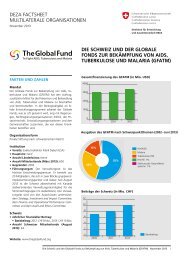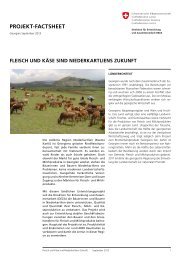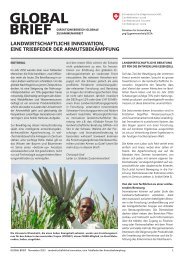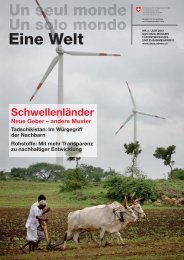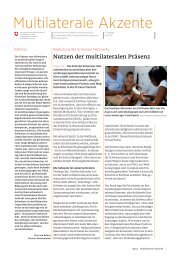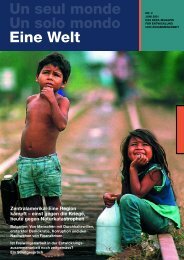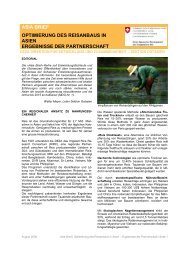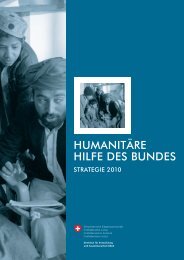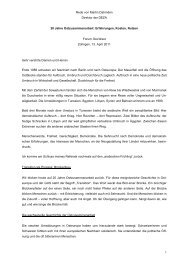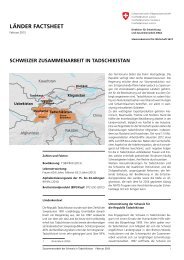12 Jahre Ostzusammenarbeit - Evaluation 2003/4 - Band 2 - DEZA
12 Jahre Ostzusammenarbeit - Evaluation 2003/4 - Band 2 - DEZA
12 Jahre Ostzusammenarbeit - Evaluation 2003/4 - Band 2 - DEZA
Sie wollen auch ein ePaper? Erhöhen Sie die Reichweite Ihrer Titel.
YUMPU macht aus Druck-PDFs automatisch weboptimierte ePaper, die Google liebt.
In zahlreichen Interviews, wie auch in der Umfrage an die Kooperationsbüros, wurden aber<br />
die Co-Finanzierungen mit den multilateralen Institutionen eher kritisch bewertet. Einigen der<br />
oben dargelegten Begründungen beziehungsweise Erwartungen an die Co-Finanzierungen<br />
wurde dabei aufgrund der Erfahrung vor Ort widersprochen. Die wichtigsten Kritikpunkte beziehungsweise<br />
Empfehlungen sind dabei die folgenden:<br />
Ø Bei der Co-Finanzierung mit Weltbank, IWF und EBRD ist die Visibilität des Schweizer<br />
Beitrages gering und es gibt wenig Chancen, wirklich effektiv etwas beizutragen. Es gibt<br />
dabei auch kaum einen Lerneffekt für das seco (ganz im Gegensatz zu den bilateralen<br />
Projekten, einschliesslich der Parallel-Finanzierungen).<br />
Ø Die gemeinsamen Aktivitäten sollten kritisch überprüft werden. Zudem müssten die Auswirkungen<br />
der Landesprogramme der multilateralen Institutionen kritischer beurteilt werden.<br />
Ø Generell sollten die seco-Projekte eine stärkere unabhängige Positionierung suchen,<br />
trotz den Bedingungen der beschränkten Implementierungskapazitäten und der Notwendigkeit,<br />
sich nach anderen Gebern mit einer Führungsrolle umzusehen.<br />
Ø Die Interessen der schweizerischen bilateralen Projekte sollten in den jeweiligen “Boards“<br />
der BWI’s und der EBRD stärker eingebracht werden.<br />
Ø Eine Herausforderung ist ein besseres und näheres Monitoring der Projekte mit seco-<br />
Co-Finanzierung.<br />
Ganz besonders deutlich wird ein kritisches Überdenken der Erfahrung mit der Co-<br />
Finanzierung im Bericht ”Co-financing budget support in Kyrgyzstan: a contentious strategy<br />
in a heavily indebted transition economy?” des “Institute of Development Studies - Sussex“<br />
(2002) angeregt. Ergänzend zu obigen kritischen Anmerkungen, wird darin auch die Abhängigkeit<br />
der Co-Finanzierung (mit “Grant“-Charakter) vom Schicksal des co-finanzierten Kredites<br />
des jeweiligen internationalen Finanzinstituts unterstrichen, insbesondere hinsichtlich<br />
dem Risiko einer Nicht-Rückzahlung des Kredits. (Siehe Zitate im untenstehenden Kasten).<br />
Zitate zur Co-Finanzierung via Weltbank im Falle des Projektes mit Kirgisistan<br />
(Quelle: Externe <strong>Evaluation</strong> [EE])<br />
“The main risk for a bilateral that co-finances a ‘benchmark-credit’ that is substantially larger than<br />
the grant money it provides relates to the possibility of non-disbursement. For instance, in the case<br />
where a benchmark-condition is not met, the larger donor may decide to delay or withhold subs equent<br />
tranches. If this happens under a co-financing arrangement, the smaller donor will be unable<br />
to disburse funds. Three potential critical concerns emerge from this. First, in the case where a<br />
bilateral donor is providing a grant element to the credit there may be a deadline by which funds<br />
need to be disbursed otherwise future funds will not be forthcoming, or will be reduced. Second, if<br />
the smaller donor does not agree with the non-disbursement decision of the larger donor does it<br />
have sufficient bargaining power to negotiate a preferred outcome with the larger donor? Third, how<br />
much damage does non-disbursement cause to other objectives of aid (ie, the predictability of go vernment<br />
resources, prevention of macroeconomic stability, etc)? We will later show that the CSAC<br />
credit illustrates an example of this problem. “<br />
”While visibility of the Swiss in PA seems very low, it is important to point out that even this low<br />
level may be exaggerated given that opinion of the value of Swiss aid was likely to be coloured by<br />
knowing that I represented Switzerland in some way. …”<br />
“Swiss project aid certainly has an excellent reputation in the Kyrgyz Republic. Words such as<br />
'pragmatic', 'people oriented', 'tangible', 'concrete support', 'livelihood securing', 'humanitarian', were<br />
all used at various times to describe Swiss involvement. However, while Swiss project aid in the<br />
KR has a very visible character and is viewed in a very positive light by do nors, Government, NGOs<br />
and rural people, Swiss contributions to PA are hardly noticed. …. The lack of visibility of Swiss<br />
grant money as a contribution to the credit suggests that policy dialogue between the World Bank<br />
and the Kyrgyz Government has contained very little reference to Swiss involvement.”<br />
”seco must decide upon the modality of PA. Generally speaking, the willingness of the Swiss to co -<br />
financing budget support depends very much upon the political motivations that the Swiss have for<br />
providing aid to the KR. If Switzerland is eager to provide quick disbursing aid, with little or no i nvolvement<br />
in monitoring and with little regard to dialogue around conditions and policy outcomes,<br />
then co-financing seems a realistic option. On the other hand, if Switzerland intends to have some<br />
influence in policy dialogue and outcome then how the Swiss position themselves will depend upon<br />
whether they agree with the dominant co-financiers’ conditionalities and whether they have enough<br />
bargaining power to influence these conditions. The issue then becomes one of short-term, versus<br />
long-term strategies.”<br />
EE<br />
EE<br />
EE<br />
47





